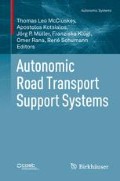Abstract
One of the most persistent problems that plague modern-day road transport facilities is the quality of service provided. Especially during rush hours, this expensive infrastructure does not operate at capacity nor does it provide the level of service required by its users. Congestion has become a problem with severe economic and environmental repercussions. Hence, efficient road traffic management is more important than ever.
Access this chapter
Tax calculation will be finalised at checkout
Purchases are for personal use only
Notes
- 1.
In fact, IBM launched the Tivoli Systems division to specifically implement autonomic properties into their computer systems.
References
Papageorgiou, M., Diakaki, C., Dinopoulou, V., Kotsialos, A., Wang, Y.: Review of road traffic control strategies. Proc. IEEE 91(12), 2043–2067 (2003)
Tincknell, D., Radcliffe, D.: A generic model of manufacturing flexibility based on system control hierarchies. Int. J. Prod. Res. 34(1), 19–32 (1996)
Williams, B.C., Nayak, P.P.: Immobile robots. AI in the new millennium. AI Mag. 17(3), 16 (1996)
Kephart, J., Chess, D.: The vision of autonomic computing. IEEE Comput. 36(1), 41–50 (2003)
Cheliotis, G., Kenyon, C.: Autonomic economics. In: Proceedings of the IEEE International Conference on E-Commerce (2003)
Warnier, M., van Sinderen, M., Brazier, M.: Adaptive knowledge representation for a self-managing home energy usage system. In: Proceedings of the Fourth International Workshop on Enterprise Systems and Technology (I-WEST), Athens, 24–25 July 2010, pp. 132–141
Agoulmine, N.: Autonomic Network Management Principles: From Concepts to Applications. Academic, Burlington (2010), http://www.sciencedirect.com/science/book/9780123821904
Truszkowski, W., Hallock, H., Rouff, C., Karlin, J., Rash, J., Hinchey, M., Sterritt, R.: Autonomous and Autonomic Systems: With Applications to NASA Intelligent Spacecraft Operations and Exploration Systems. Springer, London (2009), http://www.springer.com/gb/book/9781846282324
Etemadnia, H., Abdelghany, K., Hariri, S.: Toward an autonomic architecture for real-time traffic network management. J. Intell. Transp. Syst. 16(2), 45–59 (2012)
McCluskey, T.L., et al.: Autonomic road transport support systems: a roadmap. University of Huddersfield and EU COST Action TU 1102. http://www.cost-arts.org (2015)
Acknowledgements
This book displays results achieved by members of COST Action TU1102 “Towards Autonomic Road Transport Support Systems” (ARTS). COST (European Cooperation in Science and Technology) is a pan-European intergovernmental framework. Its mission is to enable breakthrough scientific and technological developments leading to new concepts and products and thereby contribute to strengthening Europe’s research and innovation capacities. It allows researchers, engineers and scholars to jointly develop their own ideas and take new initiatives across all fields of science and technology, while promoting multi- and interdisciplinary approaches. COST aims at fostering a better integration of less research-intensive countries to the knowledge hubs of the European Research Area. The COST Association, an International not-for-profit Association under Belgian Law, integrates all management, governing and administrative functions necessary for the operation of the framework. The COST Association has currently 36 member countries (see www.cost.eu).
We do acknowledge the support of the COST Action TU1102, run from 2011 to 2015, which has contributed immensely in building this research community and facilitating our discussions and collaborations, part of which are reported here.
Author information
Authors and Affiliations
Corresponding author
Editor information
Editors and Affiliations
Rights and permissions
Copyright information
© 2016 Springer International Publishing Switzerland
About this chapter
Cite this chapter
McCluskey, T.L., Kotsialos, A., Müller, J.P., Klügl, F., Rana, O.F., Schumann, R. (2016). Autonomic Road Transport Support Systems: An Introduction. In: McCluskey, T., Kotsialos, A., Müller, J., Klügl, F., Rana, O., Schumann, R. (eds) Autonomic Road Transport Support Systems. Autonomic Systems. Birkhäuser, Cham. https://doi.org/10.1007/978-3-319-25808-9_1
Download citation
DOI: https://doi.org/10.1007/978-3-319-25808-9_1
Published:
Publisher Name: Birkhäuser, Cham
Print ISBN: 978-3-319-25806-5
Online ISBN: 978-3-319-25808-9
eBook Packages: Computer ScienceComputer Science (R0)

